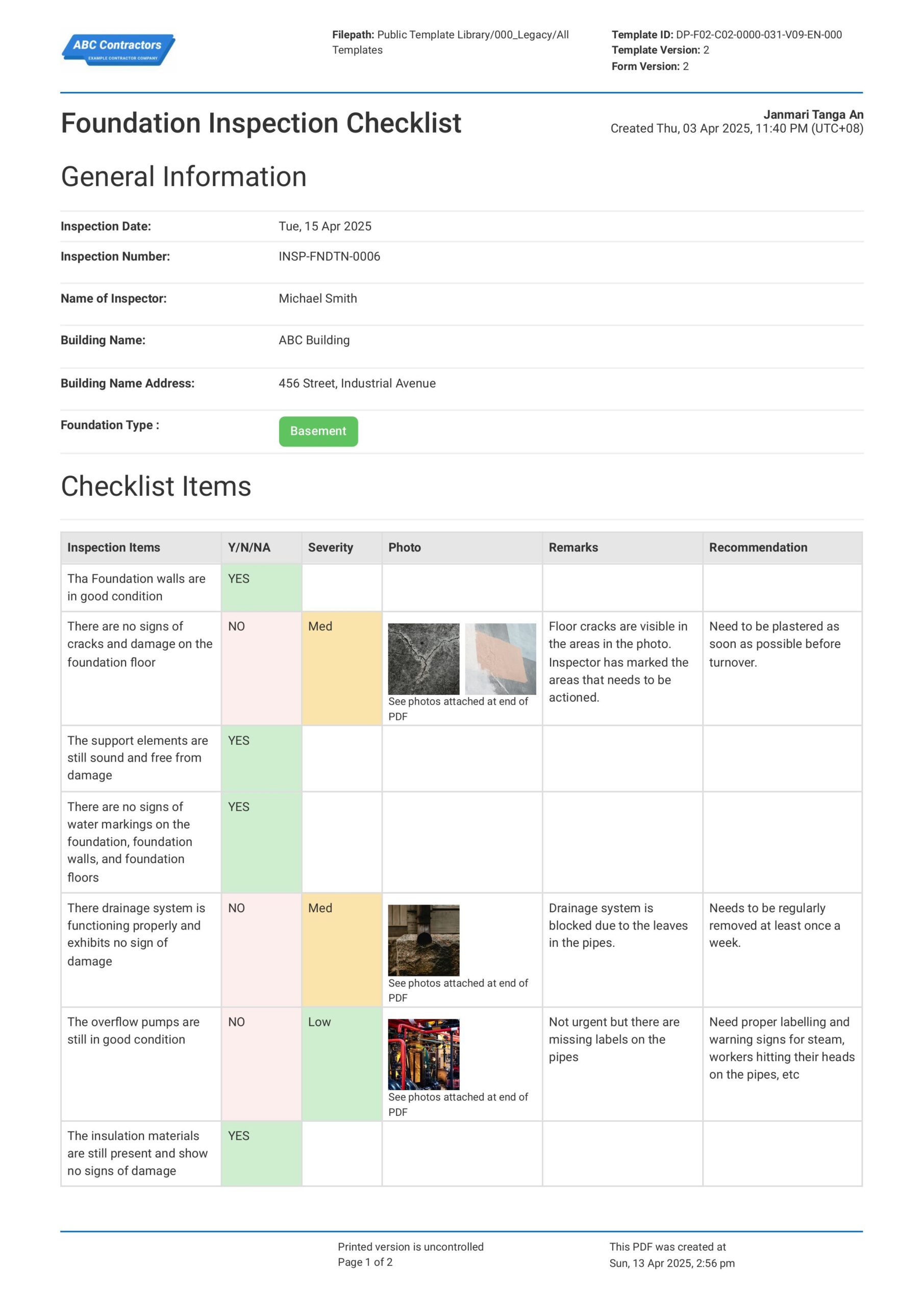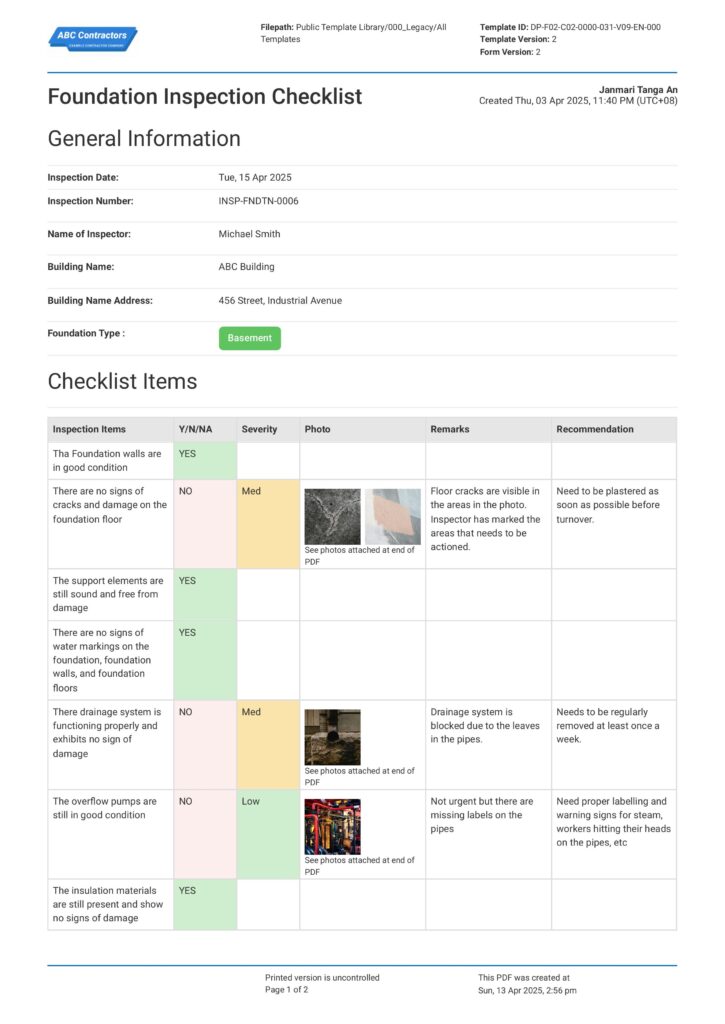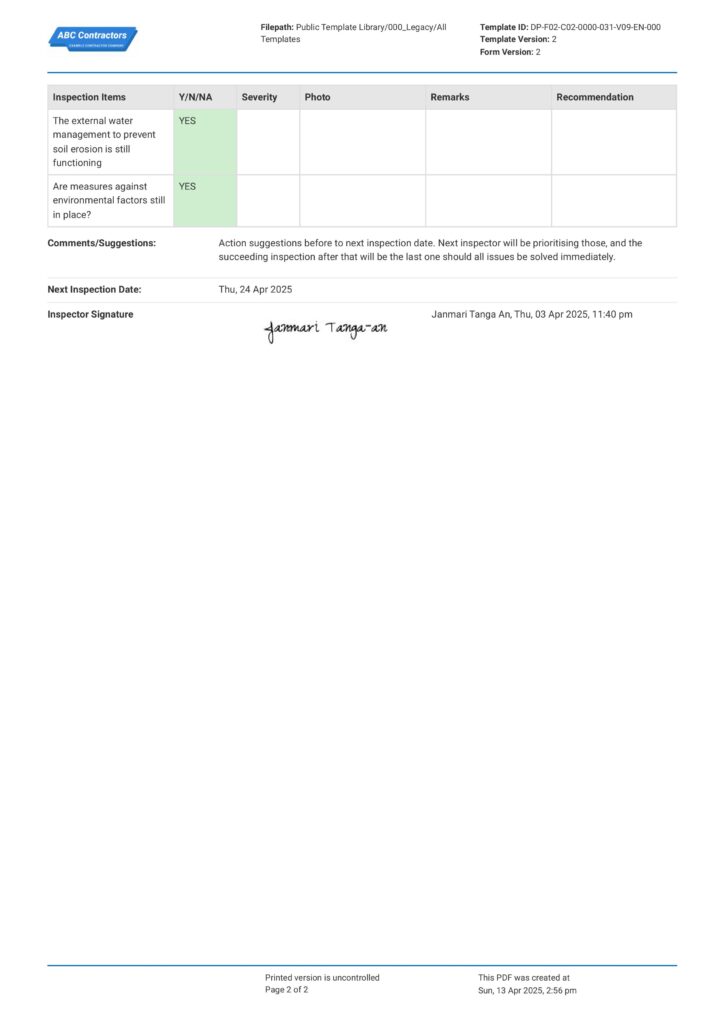Foundation Inspection Checklist Template
Start with a free 30-day trial. No credit card required.

~10,000 employees
~500 employees
~10 employees
~25,000 employees
~200 employees
~1,500 employees
~1,500 employees
What is a Foundation Inspection Checklist?
A Foundation Inspection Checklist is a comprehensive inspection checklist that aids in evaluating the conditions of the foundations in your building. It's a requirement when performing your regular building envelope inspections because it helps make sure that your building is compliant with the regulations you follow and is safe to occupy in.
The building envelope inspection is an important aspect in maintaining structural integrity, as it provides early solutions for problems and prevents them from escalating into something that might be harder to control. Especially with the foundation, it functions to distribute load evenly to the ground. You can't have issues that affect the foundation, which eventually affects the entire building. Regular inspections are necessary to ensure longevity of your foundations.
Compare this digital Foundation Inspection Checklist to manual Word, Excel and PDF forms
Use this Foundation Inspection Checklist template for free.
Why you need to conduct a foundation inspection
Conducting a foundation inspection checklist is important for preventive maintenance – you can spot potential issues and address them immediately. Here are the main reasons why you need to conduct regular inspections for your foundations.
To maintain structural integrity
The foundation inspection is a proactive approach that helps ensure the health of your foundations by identifying early issues and providing solutions for them immediately. This approach will extend the life of your foundations and maintain their structural integrity and soundness.
Keep buildings and people safe
Doing the foundation inspection also promotes the safety of the building, since having to regularly check the structural integrity of the components ensures their full functionality and durability. Weak structures create many hazards for the inhabitants and pedestrians inside the building. A structurally sound building is a safe one.
To comply with regulations
The International Building Code (IBC), developed by the International Code Council (ICC), requires establishments to conform to the general requirements of the 2021 International Property Maintenance Code (IPMC). In Chapter 3 general requirements, section 304.4, states that structural members shall be maintained free from deterioration and shall be capable of safely supporting the imposed dead and live loads. Having said that, it is important that businesses adhere to such regulations to avoid legal penalties due to non-compliance with regulations.
Top things to check in your Foundation Inspection Checklist
Bowing walls
Bowing walls are clear signs that your foundation is weakening. When foundations weaken, the load distribution becomes unbalanced. As a result, some of the force is transmitted unto the walls, but unlike foundation structures, those walls that aren’t designed to distribute loads tend to warp and bow. We must regularly monitor the deflection of bowing walls. Approaching any major changes with criticality is the best approach to mitigate it from escalating to something more serious.
Horizontal or vertical cracks in your foundation
This is the clearest sign that there is a problem with your foundation. However, it is important to distinguish which kinds of cracks indicate critical structural failure. Having the knowledge of these cracks helps you provide the right strategy on how to go about them. Here are the most common types of cracks found in foundation walls.
- Hairline cracks: These are often harmless. These vertical cracks are usually 1/8 of an inch wide, which typically develops after concrete dries off or cures.
- Vertical Cracks: These vertical or diagonal cracks usually appear wide in one area and thin out as they spread. They are about 1/4 of an inch wide and may indicate that a part of the foundation is sinking unevenly.
- Stair-step Cracks: These cracks develop because of a significant differential settlement in the foundation. This means that there is more movement in one part of the foundation, which creates an imbalance. We should approach these cracks with caution and closely monitor them. Once these cracks widen and spread through many levels, they will weaken the whole structure and lead to structural failure.
- Horizontal Cracks: These are the most dangerous cracks that establishments should take notice of. Horizontal cracks appear because lateral pressure from the soil pushes against the foundation. When this phenomenon happens, your wall starts to bulge or curve inward. This crack is a clear sign that there is an impending structural failure.
Uneven floors, doors and walls
Doors not closing properly, floors bulging or sinking, and walls warping. These are signs that there is settling in your foundation. The soil where your foundation sits may have undergone changes. It might have changed its moisture content, eroded, or expanded, which led to the problems mentioned formerly.
Water damage
Water causes many problems that might weaken your foundation. It can alter the composition of the soil where your foundation sits; it seeps into the pores of concrete, leading to corrosion; and it attracts mold, wood rot, and pests to the foundation. Inspectors must ensure they check soil moisture and look for signs of dampness on the foundation.
Foundation inspection tips and best practices
A foundation inspection usually contains general information about the building and several checklist items that inspectors go through to guide them in their inspections. These checklist items are usually related to the health and integrity of the foundation, and most of them help the inspector detect any of the common signs of foundation damage mentioned above.
- Ensure that the forms you are using are thorough enough to actually detect problems
- Provide evidence of the damage inspection would also support the claims
- Pictures would remove ambiguity and help non-technical stakeholders understand the problem.
- If a problem ever arises, this expedites the process of providing a solution.
A foundation inspection is not particularly complex – it's just a simple, proactive process to maintain a building’s structural integrity.
Frequently Asked Questions
Why is this the best Foundation Inspection Checklist template?
Sitemate's Foundation Inspection Checklist is the best building envelope inspection template because it's convenient to use and accessible for on-site inspectors. It's being used across construction and infrastructure industries and companies due to its pre-built contents and tailored capabilities that align with the best industry practices.
Is this template compliant with the common standards, like the IBC, and other building codes?
Yes – this template is aligned with the IBC and can be easily tailored that aligns with other standards like the ISO standards, and other local/regional building codes.
Can I edit and tailor this Foundation Inspection Checklist for my business or company?
Definitely – this template is fully editable, can be tailored that fits your company policies and how you conduct your foundation inspections with its easy drag-and-drop functionality. Create other thousands of potential document set-ups with multiple field types (photos, sketches, text boxes, and even formulas). Add your company logo, custom headers, and many more – all powered by Dashpivot's template builder.
What other formats is this checklist available in?
You can use this template across any type of device – computer, mobile, or tablet. Use and edit this checklist from any device and complete forms directly from the field. After filling it out, you can export documents as PDF, CSV, or a Word document – it's that easy.
Other popular templates you can use and edit for free

Window Inspection Checklist
Conduct thorough window inspections to enhance life on windows, and maintain overall building structural integrity.

Building Envelope Inspection Checklist
Detail and log issues and concerns of the building envelope with this inspection checklist.

Expansion Joint Inspection Checklist
Capture and record the structural integrity of the expansion joints in a building envelope.
This checklist was generated with Dashpivot software
Improve inspections by using this digital Foundation Inspection Checklist made by Dashpivot. Offline mode, digital signatures, autosave, and immediate sharing, the inspection report app makes reporting simpler than ever. Deploy tailored inspection reports to teams and obtain insights from your inspection report.
- Ensure all of your reports are document controlled and compliant.
- Generate inspection reports from the app in one click. Print, download or send your foundation inspection checklists as perfectly formatted PDF documents with your company logo.
- Keep all of your inspection checklists proof secure, efficient, and easy to find.
- Complete and share your inspection reports from anywhere, anytime. Invite internal and external parties to see, edit and sign off on checklists online.
Sitemate builds best-in-class software tools for built world companies.

